

Compact Muon Solenoid
LHC, CERN
| CMS-BPH-15-003 ; CERN-EP-2019-186 | ||
| Study of $\mathrm{J}/\psi$ meson production from jet fragmentation in pp collisions at $\sqrt{s} = $ 8 TeV | ||
| CMS Collaboration | ||
| 3 October 2019 | ||
| Phys. Lett. B 804 (2020) 135409 | ||
| Abstract: A study of the production of prompt $\mathrm{J}/\psi$ mesons as fragmentation products of jets in proton-proton collisions at $\sqrt{s} = $ 8 TeV is presented. The analysis is based on data corresponding to an integrated luminosity of 19.1 fb$^{-1}$ collected with the CMS detector at the LHC. For events with at least one observed jet, the angular separation between the $\mathrm{J}/\psi$ meson and the jet is used to test whether the $\mathrm{J}/\psi$ meson is a jet fragment. The analysis shows that most prompt $\mathrm{J}/\psi$ mesons with energy above 15 GeV and rapidity $|y| < $ 1 are fragments of jets with pseudorapidity $|{\eta_{\text{jet}}}| < $ 1. The differential distributions of the jet fragmentation probability as a function of jet energy for a fixed $\mathrm{J}/\psi$ energy fraction are compared to a theoretical model using the fragmenting jet function approach. The data agree best with fragmenting jet function calculations that use a long-distance matrix element parameter set in which prompt $\mathrm{J}/\psi$ mesons are unpolarized. This technique demonstrates a new way to test predictions for prompt $\mathrm{J}/\psi$ production using nonrelativistic quantum chromodynamics. | ||
| Links: e-print arXiv:1910.01686 [hep-ex] (PDF) ; CDS record ; inSPIRE record ; HepData record ; CADI line (restricted) ; | ||
| Figures | |
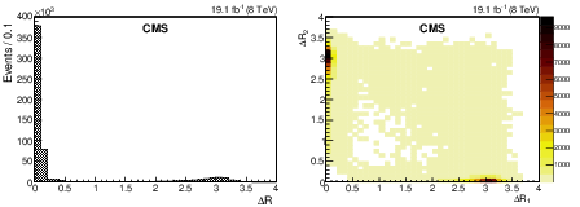
png pdf |
Figure 1:
The distributions of (left) $ {\Delta R}$ for one-jet events and (right) $ {\Delta R}_1$ vs. $ {\Delta R}_2$ for two-jet events. |
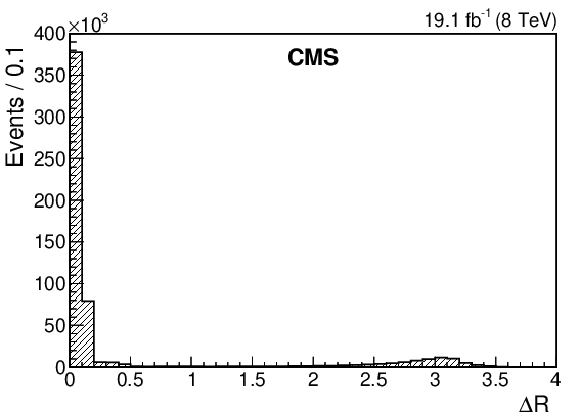
png pdf |
Figure 1-a:
The distribution of $ {\Delta R}$ for one-jet events. |
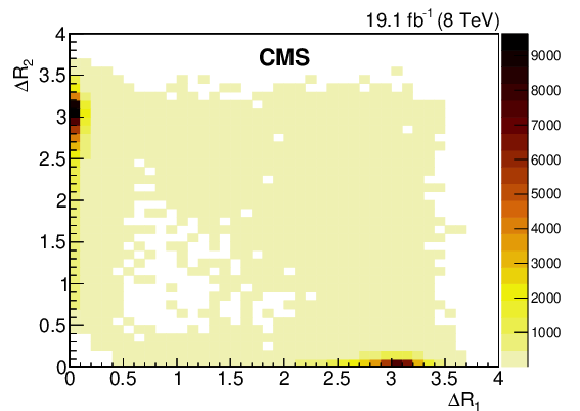
png pdf |
Figure 1-b:
The distribution of $ {\Delta R}_1$ vs. $ {\Delta R}_2$ for two-jet events. |

png pdf |
Figure 2:
Comparison of $\Xi (E_{\text {jet}}; \ 0.425)$ versus $E_{\text {jet}}$ from data with the FJF predictions from each of the four NRQCD terms, using the BCKL (left) and the BK (right) LDME parameter sets. The curves show the detailed energy dependence of the predictions. |
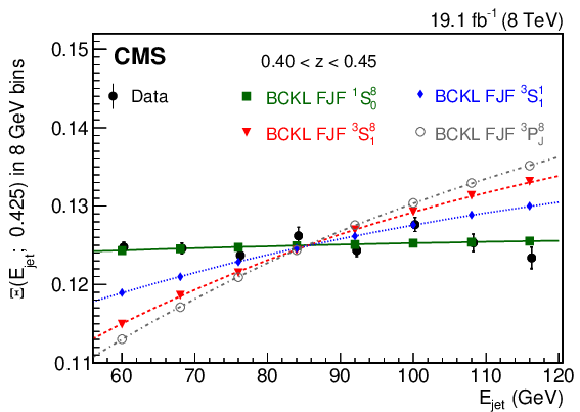
png pdf |
Figure 2-a:
Comparison of $\Xi (E_{\text {jet}}; \ 0.425)$ versus $E_{\text {jet}}$ from data with the FJF predictions from each of the four NRQCD terms, using the BCKL LDME parameter set. The curves show the detailed energy dependence of the predictions. |
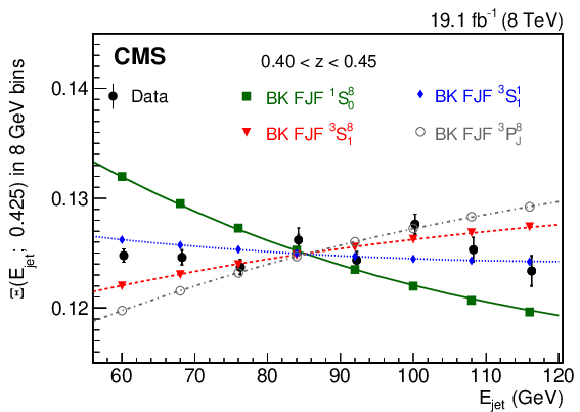
png pdf |
Figure 2-b:
Comparison of $\Xi (E_{\text {jet}}; \ 0.425)$ versus $E_{\text {jet}}$ from data with the FJF predictions from each of the four NRQCD terms, using the BK LDME parameter set. The curves show the detailed energy dependence of the predictions. |
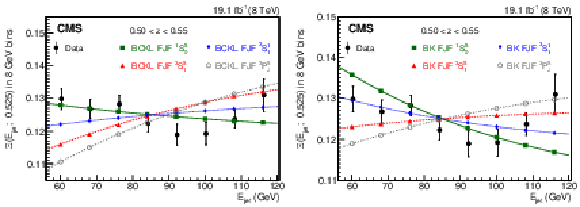
png pdf |
Figure 3:
Comparison of $\Xi (E_{\text {jet}}; \ 0.525)$ versus $E_{\text {jet}}$ from data with the FJF predictions from each of the four NRQCD terms, using the BCKL (left) and the BK (right) LDME parameter sets. The curves show the detailed energy dependence of the predictions. |
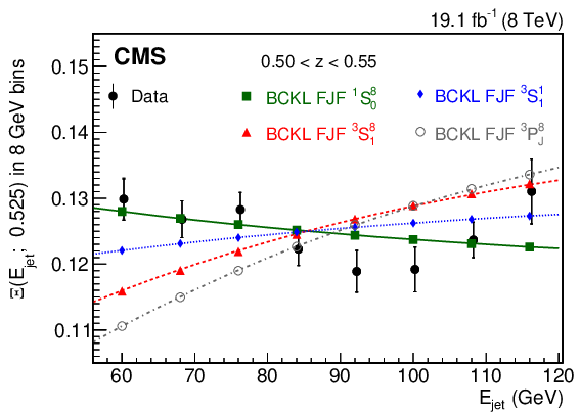
png pdf |
Figure 3-a:
Comparison of $\Xi (E_{\text {jet}}; \ 0.525)$ versus $E_{\text {jet}}$ from data with the FJF predictions from each of the four NRQCD terms, using the BCKL LDME parameter set. The curves show the detailed energy dependence of the predictions. |
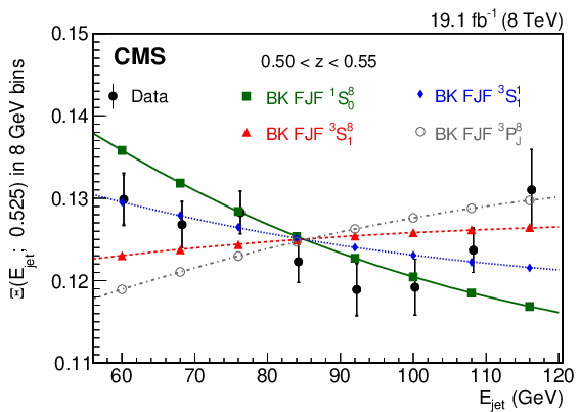
png pdf |
Figure 3-b:
Comparison of $\Xi (E_{\text {jet}}; \ 0.525)$ versus $E_{\text {jet}}$ from data with the FJF predictions from each of the four NRQCD terms, using the BK LDME parameter set. The curves show the detailed energy dependence of the predictions. |
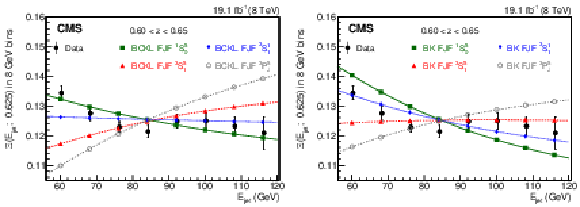
png pdf |
Figure 4:
Comparison of $\Xi (E_{\text {jet}}; \ 0.625)$ versus $E_{\text {jet}}$ from data with the FJF predictions from each of the four NRQCD terms, using the BCKL (left) and the BK (right) LDME parameter sets. The curves show the detailed energy dependence of the predictions. |
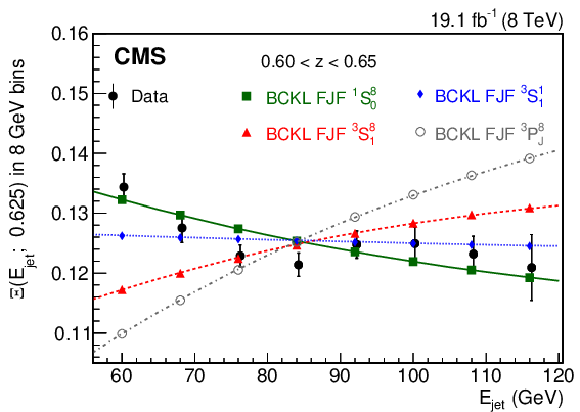
png pdf |
Figure 4-a:
Comparison of $\Xi (E_{\text {jet}}; \ 0.625)$ versus $E_{\text {jet}}$ from data with the FJF predictions from each of the four NRQCD terms, using the BCKL LDME parameter set. The curves show the detailed energy dependence of the predictions. |
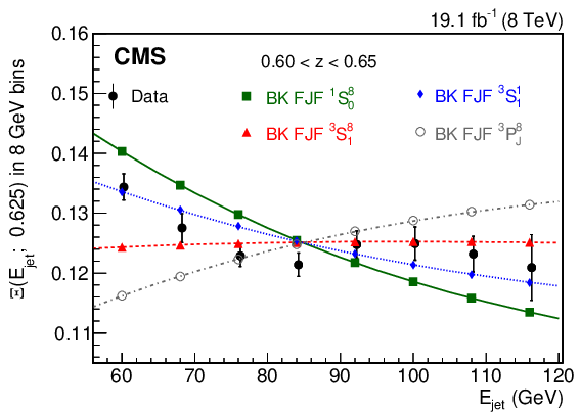
png pdf |
Figure 4-b:
Comparison of $\Xi (E_{\text {jet}}; \ 0.625)$ versus $E_{\text {jet}}$ from data with the FJF predictions from each of the four NRQCD terms, using the BK LDME parameter set. The curves show the detailed energy dependence of the predictions. |
| Tables | |

png pdf |
Table 1:
For $z_1 =$ 0.425, the $\chi ^2$ value and the associated $p$-value (in parentheses) for 7 degrees of freedom from the comparison of the data and the prediction for each FJF term, using the BCKL and BK LDME parameter sets. |

png pdf |
Table 2:
For $z_1 =$ 0.525, the $\chi ^2$ value and the associated $p$-value (in parentheses) for 7 degrees of freedom from the comparison of the data and the prediction for each FJF term, using the BCKL and BK LDME parameter sets. |

png pdf |
Table 3:
For $z_1 =$ 0.625, the $\chi ^2$ value and the associated $p$-value (in parentheses) for 7 degrees of freedom from the comparison of the data and the prediction for each FJF term, using the BCKL and BK LDME parameter sets. |
| Summary |
|
The first analysis has been presented comparing data for prompt $\mathrm{J}/\psi$ mesons produced as fragments of central gluonic jets with a theoretical analysis based on the fragmenting jet function (FJF) approach. The term prompt means that the $\mathrm{J}/\psi$ meson is consistent with originating from the primary vertex. In the FJF model, the jet fragments into a $\mathrm{c}\mathrm{\bar{c}}$ system in an angular momentum state and quark color configuration $^{2S+1}L_{J}^{n}$ plus other hadrons. Here, $S$, $L$, and $J$ are the spin, orbital, and total angular momentum quantum numbers of the $\mathrm{c}\mathrm{\bar{c}}$ system and $n$ indicates a color-singlet ($n$ = 1) or color-octet ($n$ = 8) configuration. The FJF analysis uses the nonrelativistic quantum chromodynamics (NRQCD) approach to compute the cross section for the formation of a $\mathrm{J}/\psi$ meson from the $\mathrm{c}\mathrm{\bar{c}}$ system for four specific $S$, $J$, $L$, and $n$ configurations: $^{1}S_{0}^{8}$, $^3S_{1}^{8}$, $^{3}S_{1}^{1}$, and $^3P_{J}^{8}$. The data were collected by the CMS Collaboration in proton-proton collisions at $\sqrt{s} = $ 8 TeV, corresponding to an integrated luminosity of 19.1 fb$^{-1}$ . The kinematic selections for the analysis are $E_{\mathrm{J}/\psi} > $ 15 GeV, $|{y_{\mathrm{J}/\psi}}| < $ 1, ${p_{\mathrm{T}}}^{\text{jet}} > $ 25 GeV, and $|{\eta_{\text{jet}}}| < $ 1. The agreement between the data and the FJF predictions over a wide range of $z$, where $z$ is the $\mathrm{J}/\psi$ meson fraction of the jet energy, supports the FJF model predictions for gluon jet fragmentation into $\mathrm{J}/\psi$ mesons. For three specific $z$ ranges, 0.40-0.45, 0.50-0.55, and 0.60-0.65, the $^{3}S_{1}^{8}$ and $^3P_{J}^{8}$ FJF terms do not match the fragmentation data for either the Bodwin, Chung, Kim, and Lee (BCKL) [32] or Butenschoen and Kniehl (BK) [33] long-distance matrix element (LDME) parameter sets, indicating that these terms are not the main contributors to $\mathrm{J}/\psi$ meson production by jet fragmentation. Only the nonrelativistic quantum chromodynamics (NRQCD) $^{1}S_{0}^{8}$ term, using the BCKL LDME parameters, matches the data for jet fragmentation to $\mathrm{J}/\psi$ mesons for all three $z$ ranges. The dominance of this term, which has all angular momenta equal to zero in the $\mathrm{c}\mathrm{\bar{c}}$ rest frame, would explain the experimental measurements [6,7] of small $\mathrm{J}/\psi$ meson polarization for ${p_{\mathrm{T}}}^{\mathrm{J}/\psi} > 12$ GeV. For $z > 0.5$, the NRQCD $^{3}S_{1}^{1}$ term, using the BK LDME parameters, has almost the same jet energy dependence as the BCKL $^{1}S_{0}^{8}$ term and could play the dominant role in jet fragmentation to $\mathrm{J}/\psi$ mesons. However, the $^{3}S_{1}^{1}$ NRQCD term implies a significant $\mathrm{J}/\psi$ meson polarization for $z > $ 0.5, corresponding to 16 $ < {p_{\mathrm{T}}}^{\mathrm{J}/\psi} < $ 34 GeV, in contradiction with experimental results. When a jet is observed in an event, the fraction of $\mathrm{J}/\psi$ mesons from jet fragmentation is (94.2 $\pm$ 0.1)%, averaged over one- and two-jet events. Using a simple model to estimate the fraction of $\mathrm{J}/\psi$ mesons that are fragments of jets that fail the analysis ${p_{\mathrm{T}}}^{\text{jet}}$ requirement, jet fragmentation is found to be the source of (85 $\pm$ 3 (stat) $\pm$ 7 (syst))% of the $\mathrm{J}/\psi$ mesons produced in the kinematic region probed in this study. This analysis shows that jet fragmentation accounts for almost all prompt $\mathrm{J}/\psi$ mesons produced at large ${p_{\mathrm{T}}}^{\mathrm{J}/\psi}$ and is consistent with being dominated by the $^{1}S_{0}^{8}$ FJF term using the BCKL parameter set, thus explaining the small $\mathrm{J}/\psi$ meson polarization for ${p_{\mathrm{T}}}^{\mathrm{J}/\psi} > $ 12 GeV. |
| References | ||||
| 1 | E598 Collaboration | Experimental observation of a heavy particle J | PRL 33 (1974) 1404 | |
| 2 | J.-E. Augustin et al. | Discovery of a narrow resonance in $ \mathrm{e^{+}}\mathrm{e^{-}} $ annihilation | PRL 33 (1974) 1406 | |
| 3 | C.-H. Chang | Hadronic production of $ \mathrm{J}/\psi $ associated with a gluon | NPB 172 (1980) 425 | |
| 4 | R. Baier and R. Ruckl | Hadronic production of $ \mathrm{J}/\psi $ and $ \Upsilon\text{1S} $: transverse momentum distributions | PLB 102 (1981) 364 | |
| 5 | CDF Collaboration | $ \mathrm{J}/\psi $ and $ \psi $(2S) production in $ {\mathrm{p}}\mathrm{\bar{p}} $ collisions at $ \sqrt{s}= $ 1.8 TeV | PRL 79 (1997) 572 | |
| 6 | CDF Collaboration | Polarizations of $ \mathrm{J}/\psi $ and $ \psi $(2S) mesons produced in $ {\mathrm{p}}\mathrm{\bar{p}} $ collisions at $ \sqrt{s}= $ 1.96 TeV | PRL 99 (2007) 132001 | 0704.0638 |
| 7 | CMS Collaboration | Measurement of the prompt $ \mathrm{J}/\psi $ and $ \psi $(2S) polarizations in $ {\mathrm{p}}{\mathrm{p}} $ collisions at $ \sqrt{s}= $ 7 TeV | PLB 727 (2013) 381 | CMS-BPH-13-003 1307.6070 |
| 8 | P. Cho and A. K. Leibovich | Color-octet quarkonia production | PRD 53 (1996) 150 | |
| 9 | P. Cho and A. K. Leibovich | Color-octet quarkonia production. II | PRD 53 (1996) 6203 | |
| 10 | M. Baumgart, A. K. Leibovich, T. Mehen, and I. Z. Rothstein | Probing quarkonium production mechanisms with jet substructure | JHEP 11 (2014) 003 | 1406.2295 |
| 11 | LHCb Collaboration | Study of $ \mathrm{J}/\psi $ production in jets | PRL 118 (2017) 192001 | 1701.05116 |
| 12 | J. Pumplin et al. | New generation of parton distributions with uncertainties from global QCD analysis | JHEP 07 (2002) 012 | hep-ph/0201195 |
| 13 | L. Dai and P. Shrivastava | Quarkonium polarization and the long distance matrix elements hierarchies using jet substructure | PRD 96 (2017) 036020 | 1707.08629 |
| 14 | CMS Collaboration | Determination of jet energy calibration and transverse momentum resolution in CMS | JINST 6 (2011) P11002 | CMS-JME-10-011 1107.4277 |
| 15 | CMS Collaboration | Description and performance of track and primary-vertex reconstruction with the CMS tracker | JINST 9 (2014) P10009 | CMS-TRK-11-001 1405.6569 |
| 16 | CMS Collaboration | Performance of CMS muon reconstruction in $ {\mathrm{p}}{\mathrm{p}} $ collision events at $ \sqrt{s}= $ 7 TeV | JINST 7 (2012) P10002 | CMS-MUO-10-004 1206.4071 |
| 17 | CMS Collaboration | The CMS trigger system | JINST 12 (2017) P01020 | CMS-TRG-12-001 1609.02366 |
| 18 | CMS Collaboration | The CMS experiment at the CERN LHC | JINST 3 (2008) S08004 | CMS-00-001 |
| 19 | CMS Collaboration | Prompt and non-prompt $ J/\psi $ production in $ {\mathrm{p}}{\mathrm{p}} $ collisions at $ \sqrt{s}= $ 7 TeV | EPJC 71 (2011) 1575 | CMS-BPH-10-002 1011.4193 |
| 20 | CMS Collaboration | Upsilon production cross-section in $ {\mathrm{p}}{\mathrm{p}} $ collisions at $ \sqrt{s}= $ 7 TeV | PRD 83 (2011) 112004 | CMS-BPH-10-003 1012.5545 |
| 21 | CMS Collaboration | $ \mathrm{J}/\psi $ and $ \psi $(2S) production in $ {\mathrm{p}}{\mathrm{p}} $ collisions at $ \sqrt{s}= $ 7 TeV | JHEP 02 (2012) 011 | CMS-BPH-10-014 1111.1557 |
| 22 | CMS Collaboration | Measurement of $ \mathrm{J}/\psi $ and $ \psi $(2S) prompt double-differential cross sections in $ {\mathrm{p}}{\mathrm{p}} $ collisions at $ \sqrt{s}= $ 7 TeV | PRL 114 (2015) 191802 | CMS-BPH-14-001 1502.04155 |
| 23 | CMS Collaboration | Measurements of the $ \Upsilon\text{1S} $, $ \Upsilon\text{2S} $, and $ \Upsilon\text{3S} $ differential cross sections in $ {\mathrm{p}}{\mathrm{p}} $ collisions at $ \sqrt{s}= $ 7 TeV | PLB 749 (2015) 14 | CMS-BPH-12-006 1501.07750 |
| 24 | CMS Collaboration | Particle-flow reconstruction and global event description with the CMS detector | JINST 12 (2017) P10003 | CMS-PRF-14-001 1706.04965 |
| 25 | M. Cacciari, G. P. Salam, and G. Soyez | The anti-$ {k_{\mathrm{T}}} $ jet clustering algorithm | JHEP 04 (2008) 063 | 0802.1189 |
| 26 | M. Cacciari, G. P. Salam, and G. Soyez | FastJet User Manual | EPJC 72 (2012) 1896 | 1111.6097 |
| 27 | D. J. Lange | The EvtGen particle decay simulation package | NIMA 462 (2001) 152 | |
| 28 | E. Barberio, B. van Eijk, and Z. W\cas | PHOTOS: A universal Monte Carlo for QED radiative corrections in decays | CPC 66 (1991) 115 | |
| 29 | GEANT4 Collaboration | GEANT4---a simulation toolkit | NIMA 506 (2003) 250 | |
| 30 | T. Adye | Unfolding algorithms and tests using RooUnfold | in Proceedings, PHYSTAT 2011 Workshop on Statistical Issues Related to Discovery Claims in Search Experiments and Unfolding, CERN 2011 | 1105.1160 |
| 31 | CMS Collaboration | Muon ID performance: low-$ {p_{\mathrm{T}}} $ muon efficiencies | CMS DP-2014/020 | |
| 32 | G. T. Bodwin, H. S. Chung, U.-R. Kim, and J. Lee | Fragmentation contributions to $ \mathrm{J}/\psi $ production at the Tevatron and the LHC | PRL 113 (2014) 022001 | 1403.3612 |
| 33 | M. Butenschoen and B. A. Kniehl | Next-to-leading-order tests of NRQCD factorization with $ \mathrm{J}/\psi $ yield and polarization | MPLA 28 (2013) 1350027 | 1212.2037 |
| 34 | K.-T. Chao et al. | $ \mathrm{J}/\psi $ polarization at hadron colliders in nonrelativistic QCD | PRL 108 (2012) 242004 | 1201.2675 |

|
Compact Muon Solenoid LHC, CERN |

|

|

|

|

|

|